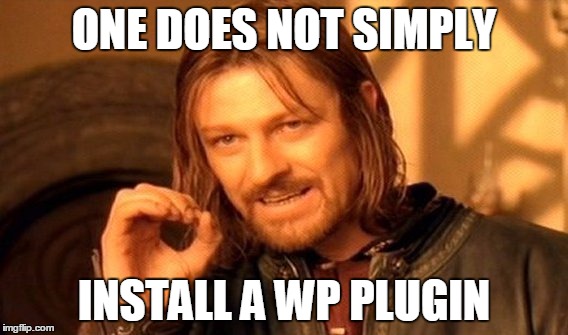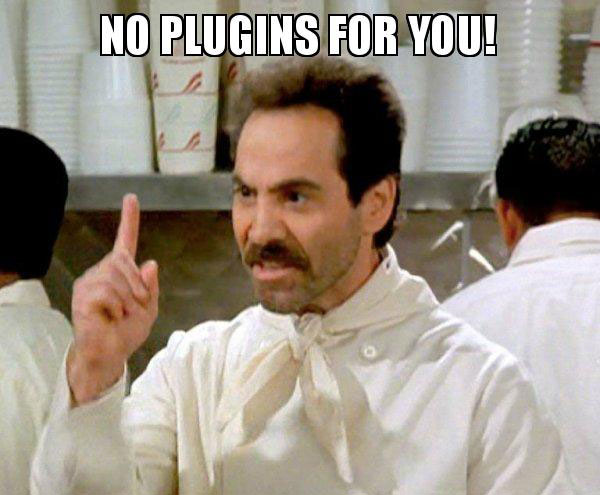Some posts only go to subscribers via email. EXCLUSIVELY.
You can read more here or simply subscribe:
Are WordPress Plugins Really Worth The Hassle?
“What hassle?” I hear you asking.
They’re wordpress plugins! They’re the best and awesomest thing in the world. They are every blogger’s little helpers, optimizing for SEO, enabling social sharing, cleaning the office room and making us coffee. They should really be called “WordPress house-elves” and not plugins. Why would anyone think they’re a hassle?
Hold on, my little possums and heed the words of the old and wise.
WordPress is awesome. I can’t argue with that. A huge community of talented programmers keep this software brilliantly effective and safe to use. Kudos to them.
Plugins are a whole different story.
1. WordPress plugins are a security risk.
WordPress itself is checked scrutinized by so many coders, it’s as safe as any software can be. Once in a blue moon a potential security loophole is discovered and patched right away with a new update.
As for plugins – or themes for that matter – there are simply too many of them out there. The current count on the official WP plugin directory stands at 45,128. Do you honestly think all of them are safe to use?
Even the more popular ones are susceptible to security loopholes, hacks and leaks, let alone plugins that only ever had 400 installs. What’s more, a plugin that’s safe today, can be unsafe tomorrow. I’m not just talking about an existing vulnerability that’s suddenly discovered. I’m talking about how changes in PHP versions or in WordPress itself can render formerly safe plugins harmful.
I know. Plugin authors should keep them up to date and patch them up as software versions change. Emphasis being on “should”. I have seen so many plugins deserted as their developers moved on to other projects. Can you be sure your plugin will be fully secure a year from now? How about five years?
2. Wordpress plugins can die on you.
And by die on you, I mean stop working altogether. The result can be a mere loss of some insignificant “behind the scenes” function, or it could mean your site crashes. It can also be anything in between, like those sites you see where a couple of lines in PHP code suddenly pop up somewhere on the page to cheerfully announce an error.
If you’re lucky, you can just deactivate the plugin or maybe switch to a competing product. Sometimes the plugin is so deeply embedded in your content, there’s not much you can do.
Plugins die all the time as talented coders move on to the next project. Especially free plugins. I can’t blame the developers. There must be a point where they tire of providing free support to so many people. That’s when you see the dreaded “this plugin is no longer supported” message on their page. From their on, you’re at the mercy of the WordPress and PHP gods. Prepare plenty of black goats to be sacrificed at midnight with every software upgrade to make sure your plugin keeps functioning.
Case in point, I once used a plugin that made it easy for me to include internal links in my posts. All I had to do was insert a certain type of bracket and presto! that word became a link going back to the page or post with the same name. It was really cool, until it stopped working and I had no choice but to go back and edit my posts to correct them.
3. There’s a learning curve to plugins.
Installation is usually (not always) a breeze but then you have to learn how to use your shiny new toy. It can take a while to figure everything out and get the results you want. Sometimes it’s worth the time invested. Other times, not so much.
4. If it’s important, it’ll get incorporated into WordPress.
I’ve been using WordPress since it was launched, back in 2003/4. Someday I’m going to take you down memory lane with me and show you what it looked like back then. Bare bones WordPress. No bells, no whistles. You could blog with it and that’s about it (and boy, that was a LOT back then!)
Then came themes and plugins. People had needs and they hacked WordPress by creating add-ons and plugins. They needed something, coded to meet that need and released that piece of code to the community. If it caught on, that meant the need was shared by many users. Often, the concept would then be absorbed into Wordpress to become an integral part of the original software. In turn, this would make the plugin redundant.
Which is wonderful, in a sense. Plugins are a way of moving the platform forward and we all benefit from that. The problem with being an early adopter is having to deal with switching from using the plugin into using the equivalent new WordPress feature. Sometimes it’s easy, other times it’s not.
The bottom line is –

No, one certainly doesn’t. Or shouldn’t.
It’s tempting, I know. WordPress makes finding plugins and installing them waaay too easy. Given half an hour, you can end up with 10-20 plugins that promise to make your blog a shiny beautiful fast lean money-making machine.
Then time passes. WordPress moves on to bigger and better versions and you get stuck with a bunch of plugins that are no longer supported and are just a security breaches waiting to happen. That’s if they don’t crash your blog first.
So, no plugins for me?

Let’s not get carried away here.
Plugins can be immensely important. There’s a reason why two of them are included with every WordPress installation. Just try running a blog without activating your Akismet plugin. Trust me, been there, tried that, deleted the blog altogether.
And as for Hello Dolly, well you just gotta have Hello Dolly. You simply must have the tune swirling in your head whenever you launch a new blog. If you don’t, your blog is bound to fail. I don’t activate it though, the title is enough to get me buzzing along.
If nothing else, you can be sure that both Akismet and the much-needed Hello Dolly plugins will always be supported and have updates. Well worth sticking to those two.
But what about other WordPress plugins?
Sigh. This is where things get complicated. For the past five years I’ve been busy with a major online project unrelated to blogging. Yes, I’ve always had a few blogs on the side. I occasionally rarely updated them with new posts here and there. I managed to keep their WordPress installation up-to-date (mainly thanks to auto updates) and that’s about it. If a plugin turned sour, I would just delete it and let the blog suffer the consequences.
Now I’m back. I’m embarking on a fresh blogging adventure. Part of it might turn out to be this very blog although my focus will likely be on one or two other new blogs. As part of my refresher course, I am now looking into WordPress plugins, the ones where the benefits outweigh the risks. My current plan is to visit those lists of “Must Have Plugins for 2016” and see what other bloggers recommend.
Will soon share my conclusions in a follow-up post. Stay tuned.
